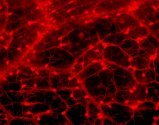
COBRE
Department of Ophthalmology
University of Oklahoma Health Sciences Center
HOME | PI | PJIs | CORES | MENTORS | IAC | EAC | SPOTLIGHT | SEMINARS | CALENDAR | AFFILIATES
John Ash, Ph.D.
Wei Cao, Ph.D.
Michael Ihnat, Ph.D.
Yun Le, Ph.D.
Raju Rajala, Ph.D.
PROMISING JUNIOR INVESTIGATOR
WEI CAO, M.D., PH.D.
COBRE Research Project
WEI CAO, M.D., PH.D.
COBRE Research Project
Photoreceptor Protection in a Mouse Model for Usher Syndrome
(Mentor, James F. McGinnis, PhD, Co-mentor, Robert Floyd, PhD)
Usher syndrome is a group of diseases with autosomal recessive inheritance, congenital hearing loss, and the development of retinitis pigmentosa, a hereditary disease that affects photoreceptor cells and causes blindness. The rd5/rd5 mouse has been identified as an animal model for Usher syndrome and linkage mapping suggests homology to Usher type I located on human chromosome 11 at p15. Growth factors such as pigment epithelium-derived factor (PEDF) and basic fibroblast growth factor (bFGF) and small molecules such as phenyl-N-tert-butylnitrone (PBN) 17-beta estradiol (E2) have been shown to protect photoreceptors from degeneration in rat model and in culture. However, the mechanism(s) by which PEDF and PBN protect photoreceptors remains unknown. Because little is known about Usher Type I disease and currently, no treatment exists for such disease, it would be important to know whether photoreceptor degeneration in rd5/rd5 mouse can also be delayed or prevented by growth factors or small molecules. The long-term objective of this proposal is to explore the roles of growth factors/small molecular weight agents in photoreceptor protection in a mouse model (rd5/rd5) for Usher syndrome with progressive retinal degeneration. The specific aims are: 1) to test the hypothesis that low molecular weight agents such as 17-beta estradiol (E2) and phenyl-N-tert-butylnitrone (PBN) can provide photoreceptor protection in rd5/rd5 mice by altering gene expression; 2) to test the hypothesis that exogenous survival factors such as PEDF or bFGF can provide photoreceptor protection in rd5/rd5 mice by altering gene expression; 3) to test the hypothesis that conditioning stress by light can induce endogenous survival promoting genes and proteins to protect photoreceptors in rd5/rd5 mice. Any of our experimental regimes that prevent the loss of photoreceptors in this mouse would be extremely relevant to the therapeutic treatment of humans with Ushers and possibly other types of inherited retinal disorders. Dr. McGinnis has extensive expertise in visual molecular biology whereas Dr. Floyd is a leading scientist in free radical research. In collaboration with Drs. Floyd, the PJI will explore the roles of PBN and E2 as neuroprotective agents for photoreceptor cells in rd5/rd5 mice. With Dr. McGinnis, the PJI will extend the collaboration in studying the survival factors in photoreceptor protection. The DNA-Microarray and Proteomics/Bioinformatics Core modules are of critical importance for differentiating the expression of genes and proteins between rd5/rd5 and rd5/+ mice with and without treatments to elucidate the mechanism(s). All animals used for this project will be housed in the Animal Core facility and electroretinography will be performed in this facility. The Image Acquisition and Production Core module will be heavy used to analyze the morphological changes and to study the localization of gene and protein expression in the retina. This project will integrate with those of Drs. Ash and Ihnat in terms of PEDF anti-angiogenic function and with those of Drs. Le and Rajala in the area of signal transduction.
Please send comments,
questions, or error reports to Holly-Whiteside@ouhsc.edu

Copyright © 2003 The Board of Regents of the University of Oklahoma, All Rights Reserved
University of Oklahoma Disclaimers
Copyright © 2003 The Board of Regents of the University of Oklahoma, All Rights Reserved
University of Oklahoma Disclaimers